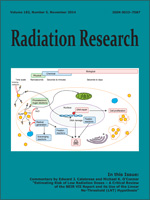Incidence and mortality from cerebrovascular disease (CVD) [International Classification of Diseases 9th revision (ICD-9) codes: 430–438] was studied in a cohort of 22,377 workers first employed at the Mayak Production Association (Mayak PA) in 1948–1982 and followed up to the end of 2008. The cohort size was increased by 19% and follow-up extended by 3 years over the previous analysis. Radiation doses were estimated using an updated dosimetry system: Mayak Worker Dosimetry System 2008 (MWDS-2008). For the first time, in an analysis of this cohort, quantitative smoking data were used. Workers of the study cohort were exposed occupationally to prolonged external gamma rays and internal alpha particles. The mean (±standard deviation) total dose from external gamma rays was 0.54 ± 0.76 Gy (95% percentile 2.21 Gy) for males and 0.44 ± 0.65 Gy (95% percentile 1.87 Gy) for females. The mean plutonium body burden in the 31% of workers monitored for internal exposure was 1.32 ± 4.87 kBq (95% percentile 4.71 kBq) for males and 2.21 ± 13.24 kBq (95% percentile 4.56 kBq) for females. The mean total absorbed alpha-particles dose to the liver from incorporated plutonium was 0.23 ± 0.77 Gy (95% percentile 0.89 Gy) in males and 0.44 ± 2.11 Gy (95% percentile 1.25 Gy) in females. After adjusting for nonradiation factors (gender, age, calendar period, employment period, facility, smoking, alcohol consumption), there were significantly increasing trends in CVD incidence associated with total absorbed dose from external gamma rays and total absorbed dose to the liver from internal alpha-particle radiation exposure. Excess relative risks per Gy (ERR/Gy) were 0.46 (95% CI 0.37, 0.57) and 0.28 (95% CI 0.16, 0.42), respectively, based on a linear dose-response model. Adjustments for additional factors (hypertension, body mass index, duration of employment, smoking index and total absorbed dose to the liver from internal exposure during the analysis of external exposure and vice versa) had little effect on the results. The categorical analyses showed that CVD incidence was significantly higher among workers with total absorbed external gamma-ray doses greater than 0.1 Gy compared to those exposed to lower doses and that CVD incidence was also significantly higher among workers with total absorbed internal alpha-particle doses to the liver from incorporated plutonium greater than 0.01 Gy compared to those exposed to lower doses. The results of the categorical analyses of CVD incidence were in good agreement with a linear dose response for external gamma-ray doses but for internal alpha-particle doses the picture was less clear. For the first time an excess risk of CVD mortality was seen in workers whose livers were exposed to internal alpha-particle doses greater than 0.1 Gy compared to those workers who were exposed to doses of less than 0.01 Gy. A significant increasing trend for CVD mortality with internal alpha-particle dose was revealed in the subcohort of workers exposed at doses <1.0 Gy after having adjusted for nonradiation factors, ERR/Gy = 0.84 (95% CI, 0.09, 1.92). These updated results provide good evidence for a linear trend in risk of CVD incidence with external gamma-ray dose. The trend for CVD incidence with internal alpha-particle dose is less clear due to the impact of issues concerning the use of dose estimates based on below the limit of detection bioassay measurements.
How to translate text using browser tools
31 October 2014
Cerebrovascular Diseases Incidence and Mortality in an Extended Mayak Worker Cohort 1948–1982
T. V. Azizova,
R. G. E. Haylock,
M. B. Moseeva,
M. V. Bannikova,
E. S. Grigoryeva
ACCESS THE FULL ARTICLE

Radiation Research
Vol. 182 • No. 5
November 2014
Vol. 182 • No. 5
November 2014




